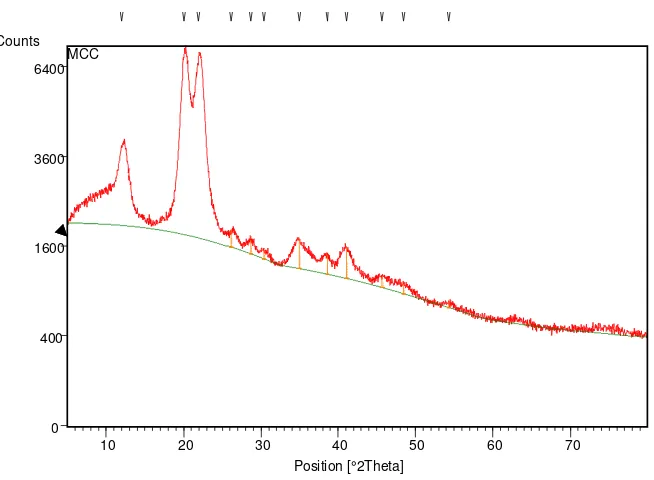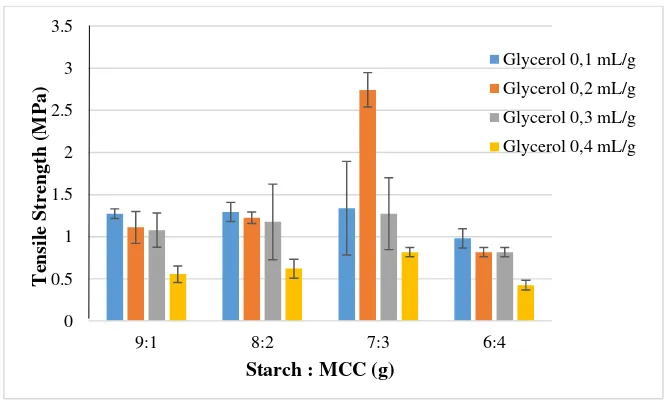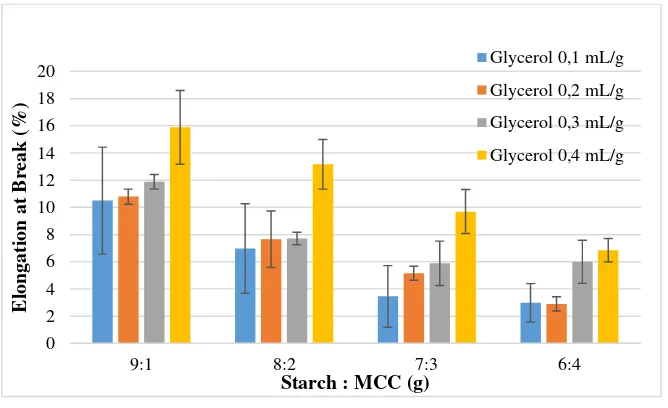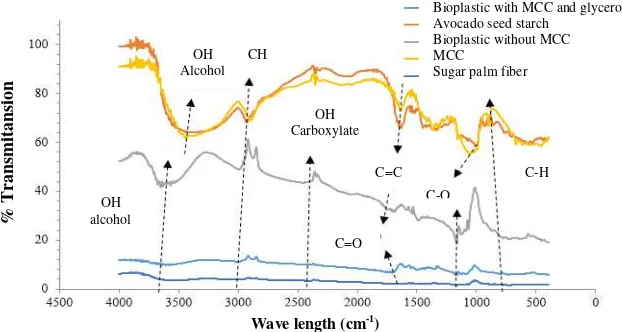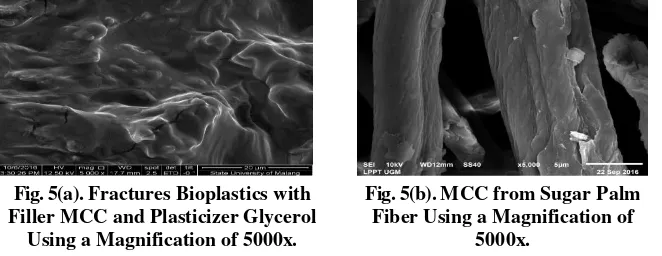© School of Engineering, Taylor’s University
PRODUCTION OF BIOPLASTIC FROM AVOCADO SEED
STARCH REINFORCED WITH MICROCRYSTALLINE
CELLULOSE FROM SUGAR PALM FIBERS
MAULIDA LUBIS1,*, MARA BANGUN HARAHAP2, MUHAMMAD HENDRA S. GINTING1, MORA SARTIKA1, HIDAYATUL AZMI1
¹Department of Chemical Engineering, Faculty of Engineering, University of Sumatera Utara, Medan, Indonesia
²Department of Physics, State University of Medan, Medan, Indonesia *Corresponding Author: maulida70@gmail.com
Abstract
The influence of microcrystalline cellulose derived from sugar palm fibers and glycerol on the mechanical properties of bioplastics from avocado seed starch was studied. Sugar palm fibers underwent alkali treatment, bleaching, and hydrolysis with HCl to produce microcrystalline cellulose. Bioplastic was successfully fabricated through solution casting technique. It was prepared from avocado seed starch and reinforced with MCC from sugar palm fibers with composition ratio of 6:4; 7:3, 8:2, and 9:1 (w/w). Glycerol functioned as plasticizer with variation of 0.1; 0.2; 0.3 and 0.4 (v/w of starch). Microcrystalline cellulose was dissolved in NaOH 5% (w/v) before it was mixed with the plasticized starch. Microcrystalline cellulose degree of crystallinity determined by X-Ray Diffraction was 97.5%. Morphological analysis was done with Scanning Electron Microscope given that the isolated microcrystalline cellulose from sugar palm fibers are rod-like shaped with diameter of 5.55-9.44 µm and crystal size of 25.08 nm. Mechanical properties of bioplastic were determined by tensile strength and elongation at break analysis where it is given that the best condition of bioplastics obtained is from 7:3 ratio with 0.2 (v/w) glycerol added which is 2.74 MPa for tensile strength and 3.16% for elongation at break. FT-IR analysis showed the functional groups of bioplastics, majority of O-H groups, that was found from the addition of microcrystalline cellulose that represented substantial hydrogen bonds.
Nomenclatures
B The half-height width of the diffraction band CrI Crystalinity index , %
I002 The crystallite height
IAM Amorphous height
K The Scherrer constant L Crystallite size, nm
Greek Symbols
The X-ray wavelength (Ǻ)
The Bragg angle, deg.Abbreviations
FTIR Fourier Transform Infra Red Spectroscopy MCC Microcrystalline Cellulose
SEM Scanning Electron Microscope XRD X-ray Diffraction
1.
Introduction
Nowadays, demand for plastic products is increasing. The need for such large quantities of conventional plastics and their dominance over other materials is due to their excellent lifelong properties which include resistance to chemical reactions, especially enzymatic reactions [1]. However, the use of conventional plastics for short-life application is not sustainable due to the increase of plastic waste that evokes environmental concern [2]. This is caused by the fact that plastics are derived from crude oil, a non-renewable fossil fuel, subsequently produces high levels of environmental pollution [3]. Biodegradable polymers commonly called bioplastic made from renewable resources as a possible alternative to reduce the number of landfill waste and other environmental issues [4].
Starch is a natural biodegradable polymer that has the potential to replace synthetic polymers used for limited time applications, i.e., disposable packaging and cutlery [2]. It is commonly found in the form of biodegradable films for varied applications as it is a renewable, abundant and inexpensive material [5]. In Indonesia, starch sources are in abundance. Avocado seed for instance, usually discarded [6], has around 30% starch content. Hence it serves as a potential starch source [7, 8].
Researchers and industries have been interested in natural fibres owing to their more specific advantages, i.e., reducing tool wear, low cost and density per unit volume compared to conventional or synthetic fibers [9]. Furthermore, its sustainable, renewable and degradable features are some of the important properties making them suitable as filler in polymer composites [10]. Cellulose has been proven to be the most promising material for reinforcing fillers [11]. Ijuk in Indonesia known as sugar palm fibers from Arenga Pinnata plant is an environmental-friendly material with 52.3% cellulose content [12, 13].
fabrication of cellulosic materials into micro and nano dimensions gives favorable characteristics such as excellent mechanical properties, high crystallinity, and low molecular weight [14]. Microcrystalline cellulose (MCC) is a pure partially depolymerized non-fibrous cellulose which is a white, odourless and tasteless crystalline powder composed of porous particles [15]. The strong interactions between MCC and starch film matrix play a key role in reinforcing the composites [16].
Starch-based bioplastic has poor dimensional stability and mechanical properties. By adding in plasticizer, it improves the workability also suppresses film brittleness [17]. Bioplastic from avocado seed waste and sugar palm fibres can reduce environmental issues from the excess use of conventional plastic [8]. The aim of this research is to obtain the influence of MCC derived from sugar palm fibers and glycerol on the mechanical properties of bioplastic.
2.
Materials and Methods
2.1.
Materials
Avocado seed was obtained from avocado merchants at Jalan H.M. Joni, Medan, Indonesia. Sugar palm fibers (ijuk) were collected from Binjai, Indonesia. NaOH, NaClO 60%, H2O2 10% for delignification and bleaching process, glycerol and HCl were purchased from Rudang Jaya, Medan, Indonesia [8].
2.2.
Starch isolation
First, peeled and washed 100 g avocado seeds and shredded into small pieces. Then it was blended in 100 ml water to give starch slurry. Next, it was filtered and placed in a tank for an hour for settling purpose. Starch sediment was formed and separated from the slurry and proceed to washing with distilled water. Settling was done for three times. Starch sediment obtained was dried in an oven at 60oC. Finally it was sieved in 100 mesh strainer to get homogenous size starch [8].
2.3.
Extraction of α
-cellulose from sugar palm fibers
Sugar palm fibers were cleaned to remove impurity and cut into small pieces. In a beaker glass, put 50 g of cleaned and cut sugar palm fibres into 700 ml HNO3 3.5% which contains 8 mg of NaNO3. The mixture was heated on a hotplate at 90oC for 2 hours. Then sugar palm fibres were washed repetitively with water until neutral pH was reached. Neutral pH fibers were added into a mixture of NaOH and Na2SO3 2%. The second mixture was heated at 50
o
C for an hour and put into washed until neutral pH was reached. Finally the fibers were heated in 340 ml of NaClO 3.5% to boil for 10 minutes and rinsed with water.
The α-cellulose was purified with 340 ml NaOH 17.5% solution at 80°C for 30 minutes. Sample was washed until pH was neutral and filtered. Then it is bleached with H2O2 10% at 60°C for 30 minutes. Last, sample was washed until pH was neutral and filtered [8].
2.4.
Isolation of MCC from α
-cellulose
in an open air for one night until suspension was formed. Suspension formed was washed until pH was neutral. Finally, it is dried in an oven at 60oC for an hour. MCC was put in a desiccator [8].
2.5.
Film preparation
10 g of dried starch and MCC were prepared in different ratios, 6 : 4, 7 : 3, 8 : 2, and 9 : 1. Then MCC was dissolved in NaOH 5% (w/v) solution and starch was dissolved in distilled water with starch : distilled water = 1 : 10 (w/v) ratio. Starch solution was heated and stirred on a hotplate for 10 minutes. Glycerol was added after into the starch solution as plasticizer in 0.1; 0.2; 0.3 and 0.4 mL/g of starch mass. The mixture of starch and glycerol was heated. At 70oC, MCC was added into the mixture and kept heated until 85oC. Next, the mixture was cooled, poured onto a flat mold and went to drying at 60oC for 24 hours. The bioplastic obtained from the process was removed from the mold, placed in a desiccator and ready to be analyzed [8].
3.
Characterization of Products
3.1.
Characterization of starch
underwent morphological analysis. The crystallinity was determined by X-Ray diffraction (XRD) (PanAnalytical X’Pr Pro) operating with CuKα radiation (λ= 1,5406 nm) at 35 mA and 40 kV. The crystallite height 002 (I002) and amorphous height (Iam) were used to calculate the apparent crystalline index (apparent Cr.I.) following Eq. (1) [18]:Functional group was analyzed using Fourier Transform Infrared (FT-IR) (Shimadzu IR-Prestige 21). The spectrum was recorded in the range of 4000 cm -1
3.3.
Mechanical properties of bioplastic
Mechanical properties of bioplastic were analyzed through tensile strength and elongation at break. Tensile strength test was based on ASTM D638 standard where product was chosen and cut to form specimen [8].
3.4.
Characterization of bioplastic
Functional group was analyzed using Fourier Transform Infrared (FTIR) (Shimadzu IR-Prestige 21). The spectrum was recorded in the range of 4000 cm -1
and 400 cm-1. Its morphology was analyzed using Scanning Electron Microscope (SEM) (JSM-5310 scanning electron microscope) at an applied accelerating voltage and current, 10 kV and 5 μA respectively [8].
4.
Results and Discussion
4.1.
Characterization of avocado seed starch
100 g of avocado seed could produce 16% of starch or 16 g of starch. It gave brown starch with particle in the size of 100 mesh. Chandra et al. (2013) reported that the phenolic compounds namely dopamine (3,4-dihydroxyphenylalanine) in avocado seed can cause enzymatic browning reactions because of oxygen [20].
Characterization of avocado seed starch was conducted to know the percentage of each component contained in the starch produced including starch, amylose, amylopectin, water, ash, and protein content to determine the quality of starch produced [8, 21]. Composition of isolated starch is shown in Table 1.
Table 1. Composition of isolated starch from avocado seeds.
Component of avocado seed starch Percentage (%)
Water 16.6
Ash 0.23
Lipid 1.09
Protein 2.16
Amylose 0.07
Amylopectin 73.55
4.2.
MCC yield
MCC derived from sugar palm fibers made gave 60% of yield [8]. In this research, the MCC produced was a good material as it was white odorless granular powder.
4.3.
Crystalinity and crystallite size of MCC
Fig. 1. XRD patterns of MCC samples derived from sugar palm fibers.
The absorption peaks that occurred at 2-theta (2θ) were 12.01o
(Iam) and 20.06o (I002) [8]. The sharp peaks indicate high crystallinity degree in MCC structure [8, 22].
High crystallinity index of MCC obtained was 97.5% [8]. It is consider high, as other non-wood indexes are at 52 - 53% [22]. High crystallinity is related to acid hydrolysis process in MCC preparation where in cellulosic materials, amorphous regions are disintegrated, resulting in highly crystalline substrate with differen degrees of crystallinity index [23]. Karim et al. (2014) reported for the treated sample, disordered amorphous regions decrease with the increase of hydrogen bond crystalline region in cellulosic matrix, which might be due to the partial breaking up of glycosidic linkages inside the amorphous region while the crystalline region almost unaltered [8, 24].
Crystallite size can be calculated from XRD result where the absorption peak of the spectra produced was at 2θ = 20.06o. By calculating the crystallite size of MCC at the absorption peak 2θ = 20.06o
, we can get crystals diameter which is equal to 25.08 nm. Crystallite size affects the compatibility or the compactness of a material where the smaller the size, the more its compatibility of a material improved [25].
4.4.
Tensile strength of bioplastics
The effects of microcrystalline cellulose derived from sugar palm fiber and glycerol to bioplastic tensile strength are shown in Fig. 2.
Position [°2Theta]
10 20 30 40 50 60 70
Counts
0 400 1600 3600 6400
Fig. 1. The effect of MCC from sugar palm
fibers and glycerol addition on tensile strength of bioplastics.
Figure 2 shows that with the increase mass of MCC, tensile strength for bioplastics increases. 7 g of MCC and 0.2 v/w glycerol gave the maximum tensile strength at 2.74 MPa. The addition of MCC on gelatinized starch films resulted in intermolecular hydrogen bonding to group which cause molecular bonds between amylose to be more compact [26].
A decrease in tensile strength value is shown for bioplastic with 4g MCC for all variation of glycerol. According to Wittaya (2009) this deviation is possibly due to the higher content of MCC that retard the intermolecular interaction which hasten the formations of aggregates and heterogeneous film [16].
Figure 2 also shows that more glycerol caused decreases in bioplastic tensile strength. The high tensile strength values can be attributed to the number of hydrogen bonds between the starch chains that contribute to cohesiveness and low flexibility. When glycerol was incorporated in the starch network, competition for the formation of hydrogen bonding started. As a result, direct interactions between starch chains were partly reduced due to hydrogen bond formation with glycerol, allowing the polymer chains to have more freedom of motion [27]. Abdorreza et al. (2011) reported that the flexibility of the film could be increased by increasing the plasticizer content, but this can lead to plasticizer crystallization in the film [8, 28].
4.5.
Elongation at break of bioplastics
The effects of increasing MCC and glycerol content to bioplastic for bioplastic elongation at break are shown in Fig. 3.
0 0.5 1 1.5 2 2.5 3 3.5
9:1 8:2 7:3 6:4
T
ens
ile
Str
eng
th (
M
P
a
)
Starch : MCC (g)
Glycerol 0,1 mL/g
Glycerol 0,2 mL/g
Glycerol 0,3 mL/g
Fig. 3. The effect of MCC from sugar palm fiber and glycerol addition on elongation at break of bioplastics.
Figure 3 shows that elongation at break value decreased with the addition of MCC content. Meanwhile, addition of plasticizers to bioplastics have the opposite effect. Addition MCC fillers from 1 to 4 g caused decrease in elongation at break value from 15,88% to 2,90%. Bioplastic with MCC content 1 g and 0.4 (v/w) glycerol gave the maximum elongation at break value at 15,88%. The best mechanical properties of bioplastic obtained (Table 2) when MCC and glycerol were at 3 g and 0.2 (v/w) which gave 3.16% elongation at break. The desired flexibility of bio packaging films is dependant on their intended application and subsequent packaged food transportation, handling and storage [17].
The increasing elongation in film is due to decrease in plasticizers in the intermolecular bonds between amylose, amylopectin and amylose-amylopectin in the starch matrix and thus substituted by hydrogen bonds formed between plasticizer and starch molecules. Such disruption and reconstruction in starch molecular chains reduce the rigidity and promotes flexibility of film by allowing more chain mobility [17]. Reduction in elongation at break value is as a result of the addition of MCC mass and reduction of glycerol roles as plasticizer. MCC tends to be more interactive with hydrogen and other monomers in bioplastics [8, 29]. These results clearly show that proper amount of MCC in starch solution increases ductility [30].
Table 2. Mechanical properties of bioplastic
from avocado seed starch with varying amount of MCC and glycerol
Treatment (starch:MCC)
Tensile strength (MPa) Elongation at break (%)
4.6.
Functional group analysis
The FTIR spectra of MCC, sugar palm fibers, avocado seeds starch, bioplastic from avocado seeds starch without MCC and bioplastic from avocado seeds starch with MCC and glycerol are shown in Fig. 4.
Fig. 4. The FTIR analysis results of avocado seeds starch, MCC, sugar palm fiber, bioplastic from avocado seeds starch without MCC, and
bioplastic from avocado seeds starch with MCC and glycerol.
FT-IR analysis for avocado seed starch shows O-H group bonded with hydrogen, C-H alkanes, C=O and C-O ethers [8]. They represented the composition of avocado seed starch, amylose-amylopectin and reducing glucose (C6H10O5)n [31]. This result is the same as Ginting’s and Tarigan’s (2015) functional group analysis of avocado seed starch [21].
The FTIR analysis results for MCC and sugar palm fibers give C-O stretch (1997) in Lubis (2016) the loss of absorption peaks at wavenumber in the range of 1500-1400 cm-1 shows that the existence of lignin and hemicellulose has been terminated properly due to delignification process with acid and bleaching treatment that have removed lignin and hemicellulose from lignocellulosic material [32, 33].
From Fig. 4 can also be seen the comparison of bioplastic without MCC and bioplastic with MCC and glycerol have the same functional groups with no new
hydrogen bonds are in between amylose-amylose, amylose-amylopectin, MCC-MCC and amylose-MCC-MCC-amylopectin chains [8, 34].
4.7.
Morphological analysis using scanning electron microscope (SEM)
SEM micrographs of fractures bioplastics with MCC filler and glycerol as plasticizer also MCC derived from sugar palm fibersin 5000x magnification are shown in Fig. 5.Fig. 5(a). Fractures Bioplastics with Filler MCC and Plasticizer Glycerol
Using a Magnification of 5000x.
Fig. 5(b). MCC from Sugar Palm Fiber Using a Magnification of
5000x.
It can be seen from Fig. 5(a) that bioplastic film has jagged surface and less compact structure as void presence was found in the film. It was caused by microcrystalline cellulose which did not dissolved completely in NaOH 5% [8]. Wang et al (2008) reported that solubility of microcrystalline cellulose in NaOH is only about 25-30% [35]. Less compact structure from these fibers resulting in more water absorption. The figure also shows less smooth surfaces with cavities as a result of non-homogenous film [29].
Figure 5(b) shows MCC derived from sugar palm fibers are rod shaped with average diameter of 5.55-9.44 µm [8]. It is the same as MCC obtained from sisal with needle or rod shapes [36, 37]. Shapes of particle should be a critical determinant to determine density. It also reflected porosity where particles with larger size have lower porosity and spesific surface area [8, 38]. The particle size of this MCC had a bigger particle size when compared to other non-wood MCC sources, such as rice straw and cotton stalks [39].
5.
Conclusions
Microcrystalline cellulose can be isolated from sugar palm fiber through alkali treatment and acid hydrolysis. Rod-shaped microcrystalline cellulose with an average diameter of 5.55-9.44 µm, crystallinity of 97.5% and crystallite size of 25.08 nm was obtained from sugar palm fiber. Starch-based bioplastic films can be prepared by polymers solution casting with isolated MCC as reinforcing filler. The best bioplastics obtained is at mass starch : MCC = 7 : 3 ratio with 0.2 (v/w) glycerol giving 2.74 MPa tensile strength and 3.16% elongation at break.
Acknowledgment
Higher Education, Contract Number: 017/SP2H/LT/DRPM/II/2016, 17th February 2016.
References
1. Ezeoha, S.L.; and Ezenwanne, J.N. (2013). Production of biodegradable plastic packaging film from cassava starch. Journal of Engineering (IOSRJEN), 3(10), 14-20.
2. Muneer, F. (2014). Bioplastics from natural polymers. Introductory paper at the Faculty of Landscape Architecture, Horticulture and Crop Production Sciences, Alnarp.
3. Ulloa, M.J.V.; and PunínBurneo, M.G. (2012). Development of starch biopolymers from waste organic materials (cassava peel) and natural fiber (agave). Journal of Materials Sciences and Engineering, 2(11), 728-736. 4. Šprajcar, M.; Horvat, P.; and Kržan, A. (2012). Biopolymers and bioplastics.
Ljubljana.
5. Alves, J.S.; Reis, K.C.; Menezes, E.G.T.; Pereira, F.V.; and Pereira, J. (2015). Effect of cellulose nanocrystals and gelatin in corn starch plasticized films. Carbohydrat Polymer, 115(2015), 215-222.
6. Mahawan, M.A.; Tenorio, M.F.N.; and Gomez, J.A. (2015). Characterization of fluor from avocado seed kernel. Asia Pasific Journal Multidisciplinary Research, 3(4), 34-40.
7. Woldu, A.R.; and Tsigie, Y.A. (2015). Optimization of hydrolysis for reduced sugar determination from avocado seed wastes. American Journal of Environment, Energy and Power Research, 3(1), 1-10.
8. Lubis, M.; Harahap, M.B.; Ginting, M.H.S.; Sartika, M.; and Azmi, H. (2016). Effect of microcrystalline cellulose (mcc) from sugar palm fibres and glycerol addition on mechanical properties of bioplastic from avocado seed starch (persea americana mill). Proceedings of Engineering & Technology, Computer, Basics & Applied Sciences. Phuket, Thailand, 331(2011), 1-10. 9. Jawaid, M.; and Abdul Khalil, H.P.S. (2011). Cellulosic/synthetic fibre
reinforced polymer hybrid composites: A review. Carbohydrat Polymer, 86(1), 1-18.
10. Saba, N.; Tahir, P.; and Jawaid, M. (2014). A Review on potentiality of nano filler/natural fiber filled polymer hybrid composites. Polymers (Basel)., 6(8), 2247-2273.
11. Maulida; Siagian, M.; and Tarigan, P. (2016). Production of starch based bioplastic from cassava peel reinforced with microcrystalline celllulose avicel PH101 using sorbitol as plasticizer. Journal of Physics: Conference Series, 710. 12. Sahari, J.; Sapuan, S.M.; Ismarrubie, Z.N.; and Rahman, M.Z.A. (2012).
Physical and chemical properties of different morphological parts of sugar palm fibres. Fibers & Textiles in Eastern Europe, 2(91), 21-24.
14. de Mesquita, J.P.; Donnici, C.L.; and Pereira, F.V. (2010). Biobased nanocomposites from layer-by-layer assembly of cellulose nanowhiskers with chitosan. Biomacromolecules, 11(2), 473-480.
15. Suvachittanont, S.; and Ratanapan, P. (2013). Optimization of micro crystalline cellulose production from corn cob for pharmaceutical industry investment. Journal of Chemical Engineering, 7(12), 1136-1141.
16. Wittaya, T. (2009). Microcomposites of rice starch film reinforced with microcrystalline cellulose from palm pressed fiber. 500, 493-500.
17. Sanyang, M.L.; Sapuan, S.M.; Jawaid, M.; Ishak, M.R.; and Sahari, J. (2015). Effect of plasticizer type and concentration on tensile, thermal and barrier properties of biodegradable films based on sugar palm (arenga pinnata) starch. Polymers (Basel), 7(6), 1106-1124.
18. Wang, Q.; Chen, Q.; Niida, H.; Mitsumura, N.; and Endo, T. (2014). Effect of water content on crystalline structure of ionic liquids mixture pretreated microcrystalline cellulose (MCC). Materials Sciences and Applications, 5(4), 183-192.
19. Meier, Mike. (2005). Measuring crystallite size using X-Ray Diffraction, the Williamson-Hall Technique. Department of Chemical Engineering and Material Science. University of California, Davis.
20. Chandra, A.; Inggrid, H.M.; and Verawati. (2013). Pengaruh pH dan jenis pelarut pada perolehan dan karakterisasi pati dari biji alpukat. Lembaga Penelitian dan Pengabdian Masyarakat, Universitas Katolik Parahyangan, Bandung, Indonesia.
21. Ginting, M.H.S.; and Tarigan, M.F.R. (2015). Effect of gelatinization temperature and chitosan on mechanical properties of bioplastics from avocado seed starch (Persea Americana mill) with plasticizer glycerol. The International Journal of Engineering and Science (IJES), 4(12), 36-43. 22. Jahan, M.S.; Saeed, A.; He, Z.; and Ni, Y. (2011). Jute as raw material for the
preparation of microcrystalline cellulose. Cellulose, 18(2), 451-459.
23. Costa, S.S.; Moris, V.A.S.; and Rocha, S.C.S. (2011). Influence of process variables on granulation of microcrystalline cellulose in vibrofluidized bed. Powder Technology, 207(1), 454-460.
24. Karim, Z.; Chowdhury, Z.Z.; Bee, S.; Hamid, A.; and Ali, E. (2014). Statistical optimization for acid hydrolysis of microcrystalline cellulose and its physiochemical characterization by using metal ion catalyst. Materials (Basel), 7(10), 6982-6999.
25. Setyawan, D.W.I.; Widjaja, B.; and Sari, R. (2013). study on crystalinity and compactibility of binary mixture of analgesic substances with microcrystalline cellulose. International Journal of Pharmacy and Pharmaceutical Sciences, 5(3), 3-8.
26. Damar, D.; and Krisna, A. (2011). Pengaruh regelatinisasi dan modifikasi hidrotermal terhadap sifat fisik pada pembuatan edible film dari pati kacang merah (Vigna angularis sp.). Thesis, Department of Chemical Engineering, Universitas Diponegoro, Semarang, Indonesia.
28. Abdorreza, M.N.; Cheng, L.H.; and Karim, A.A. (2011). Food hydrocolloids effects of plasticizers on thermal properties and heat sealability of sago starch films. Food Hydrocolloids, 25(1), 56-60.
29. Setiani, W.; Sudiarti, T.; and Rahmidar, L. (2013). Preparasi dan karakterisasi edible film dari poliblend pati. Valensi, 3(2), 100-109.
30. Tsou, C.; Suen, M.; Yao, W.; Yeh, J.; Wu, C.; Hung W.; De Guzman, C. Hu, and Lee, K. (2014). Preparation and characterization of bioplastic-based green renewable composites from tapioca with acetyl tributyl citrate as a plasticizer. Materials (Basel)., 7(8), 5617-5632.
31. Irwan, A.; Sunardi, and Syabatini, A. (2013). Polimer superabsorben berbasis akrilamida (aam) tercangkok pati bonggol pisang (Musa paradisiaca). Prosiding Semirata FMIPA Universitas Lampung. Lampung, Indonesia. 32. Dufresne, A.; Caville, J.; and Vignon, M. (1997). Mechanical behavior of
sheets prepared from sugar beet cellulose microfibrils. Journal of Applied Polymer Sciences, 64(6), 1185-1194.
33. Lubis, M. (2016). Pengaruh aging pada film lateks karet alam berpengisi nanokristalin selulosa dan penyerasi alkanolamida. Department of Chemical Engineering, Universitas Sumatera Utara. Medan, Indonesia.
34. Ginting, M.H.S.; Kristiani, M.; and Siagian, Y.A. (2016). The effect of chitosan , sorbitol, and heating temperature bioplastic solution on mechanical properties of bioplastic from durian seed starch (Durio zibehinus). Princ. author al. International Journal of Engineering Research and Application, 6(1), 33-38.
35. Wang, N.; Ding, E.; and Cheng, R. (2008). Preparation and liquid crystalline properties of spherical cellulose nanocrystals. 24(1), 5-8.
36. Habibi, Y.; Lucia, L.A,; and Rojas, O.J. (2010). Cellulose nanocrystals: chemistry, self-assembly, and applications. Chemical Reviews., 110(6), 3479-3500.
37. Sumaiyah; Wirjosentono, B.; Karsono; Nasution, M.P.; and Gea, S. (2014). Preparation and characterization of nanocrystalline cellulose from sugar palm bunch ( Arenga pinnata (Wurmb) Merr.). International Journal of PharmTech Research, 6(2), 814-820.
38. Bhimte, N.A.; and Tayade, P.T. (2007). Evaluation of microcrystalline cellulose prepared from sisal fibers as a tablet excipient : a technical note. AAPS PharmSciTech, 8(1), 1-7.

